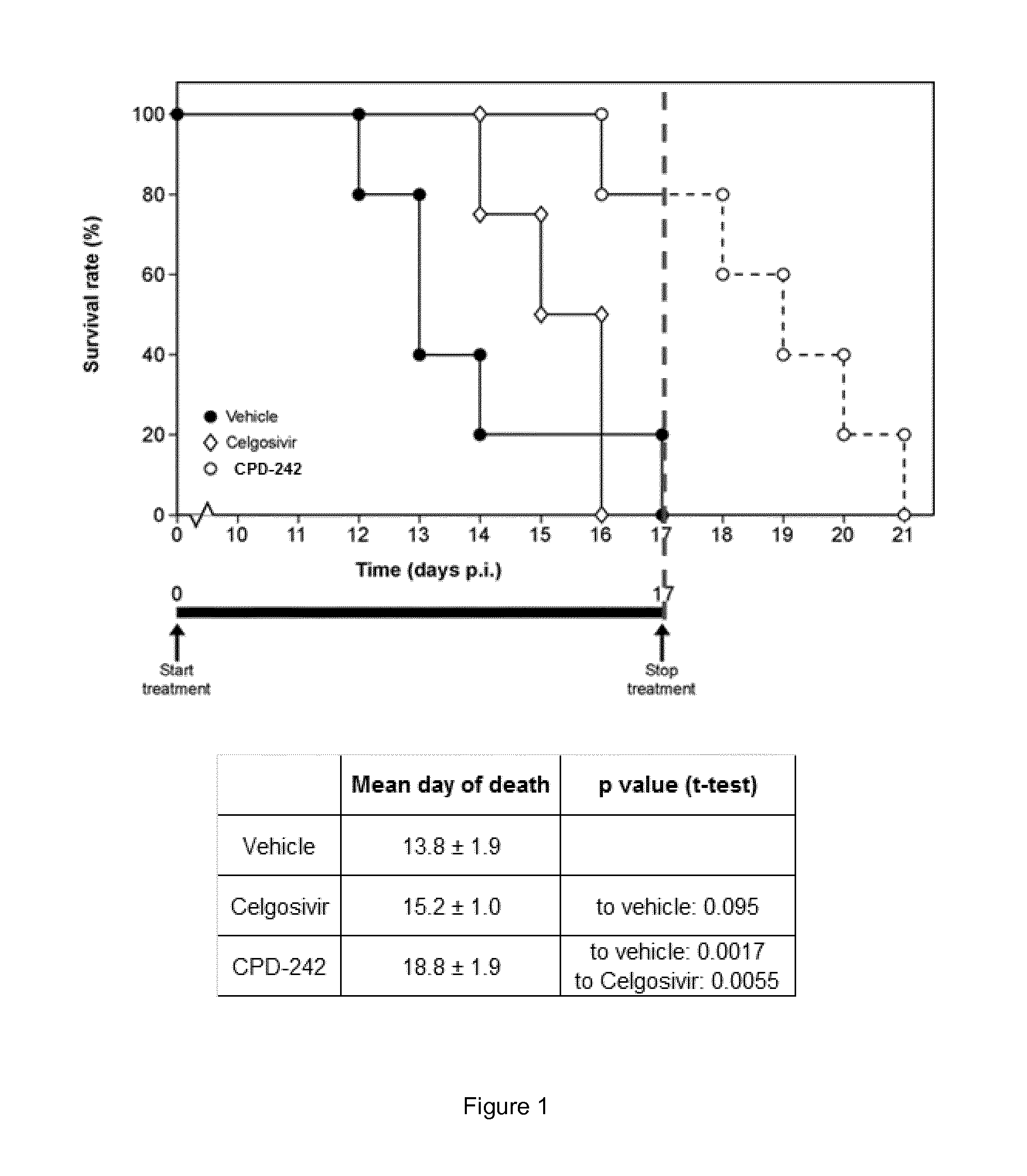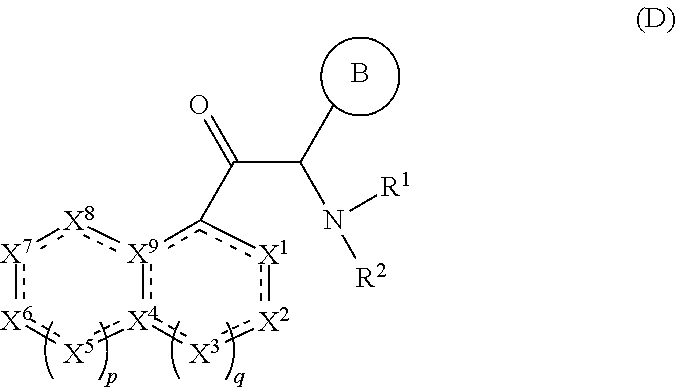Viral replication inhibitors
a technology of replication inhibitors and antiviral activity, which is applied in the field of viral replication inhibitors, can solve the problems of increasing the number of dengue cases, the increase of dengue infections, and the death of children in endemic regions, so as to achieve the effect of efficiently inhibiting the proliferation of viruses and possessing antiviral activity
- Summary
- Abstract
- Description
- Claims
- Application Information
AI Technical Summary
Benefits of technology
Problems solved by technology
Method used
Image
Examples
example 1
PREPARATION OF 2-((3,4-dimethoxyphenyl)amino)-1-(1H-indol-3-yl)-2-phenylethanone
Step 1:
[1020]2-Chloro-1-(1H-indol-3-yl)-2-phenylethanone was prepared according to general procedure A from indole (1.000 g; 8.536 mmol), pyridine (0.690 mL; 8.531 mmol) and α-chlorophenylacetyl chloride (1.610 g; 8.565 mmol) in toluene (22 mL). Purification by precipitation furnished 1.294 g (56%) of the desired compound as a white solid. ESI / APCI(+): 270, 272 (M+H); 292, 294 (M+Na). ESI / APCI(−): 268, 270 (M−H).
Step 2:
[1021]2-((3,4-Dimethoxyphenyl)amino)-1-(1H-indol-3-yl)-2-phenylethanone was prepared according to general procedure B from 2-chloro-1-(1H-indol-3-yl)-2-phenylethanone (0.125 g; 0.463 mmol), 4-aminoveratrole (0.142 g; 0.927 mmol) and triethylamine (0.200 mL; 1.443 mmol) in DMF (2 mL). Purification by flash chromatography on silica gel using a gradient of ethyl acetate (10% to 100%) in heptane followed by recrystallization from ethanol furnished 0.014 g (8%) of the desired compound as a beig...
example 2
PREPARATION OF 2-((3,5-dimethoxyphenyl)amino)-1-(1H-indol-3-yl)-2-phenylethanone
[1022]2-((3,5-Dimethoxyphenyl)amino)-1-(1H-indol-3-yl)-2-phenylethanone was prepared according to general procedure B from 2-chloro-1-(1H-indol-3-yl)-2-phenylethanone (0.054 g; 0.200 mmol), 3,5-dimethoxyaniline (0.068 g; 0.444 mmol) and triethylamine (0.100 mL; 0.717 mmol) in DMF (2 mL). Purification by flash chromatography on silica gel using a gradient of ethyl acetate (10% to 100%) in heptane followed by recrystallization from ethanol furnished 0.005 g (6%) of the desired compound as a beige solid. ESI / APCI(+): 387 (M+H). ESI / APCI(−): 385 (M−H). 1H NMR (DMSO-d6) δ 12.12 (1H, br s); 8.88 (1H, s); 8.16 (1H, m); 7.61-7.64 (2H, m); 7.45 (1H, m); 7.14-7.31 (5H, m); 6.35 (1H, m); 6.03-6.08 (3H, m); 5.70 (1H, s); 3.61 (6H, s).
example 3
PREPARATION OF 2-((3-ethoxyphenyl)amino)-1-(1H-indol-3-yl)-2-phenylethanone
[1023]2-((3-Ethoxyphenyl)amino)-1-(1H-indol-3-yl)-2-phenylethanone was prepared according to general procedure C from 2-chloro-1-(1H-indol-3-yl)-2-phenylethanone (0.050 g; 0.185 mmol), 3-ethoxyaniline (0.100 mL; 0.751 mmol) and DIPEA (0.100 mL; 0.574 mmol) in DMF (2 mL), irradiated in a microwave oven at 180° C. for 15 min. Purification by flash chromatography on silica gel using a gradient of ethyl acetate (10% to 40%) in heptane furnished 0.010 g (15%) of the desired compound as a beige solid. ESI / APCI(+): 371 (M+H); 393 (M+Na). ESI / APCI(−): 369 (M−H). 1H NMR (CDCl3) δ 8.56 (1H, br s); 8.41 (1H, m); 8.01 (1H, d); 7.53-7.55 (2H, m); 7.40 (1H, m); 7.20-7.32 (5H, m); 7.01 (1H, m); 6.29 (1H, d); 6.20-6.24 (2H, m); 5.72 (1H, m); 5.52 (1H, m); 3.94 (2H, q); 1.35 (3H, t).
PUM
| Property | Measurement | Unit |
|---|---|---|
| structure | aaaaa | aaaaa |
Abstract
Description
Claims
Application Information
 Login to View More
Login to View More - R&D
- Intellectual Property
- Life Sciences
- Materials
- Tech Scout
- Unparalleled Data Quality
- Higher Quality Content
- 60% Fewer Hallucinations
Browse by: Latest US Patents, China's latest patents, Technical Efficacy Thesaurus, Application Domain, Technology Topic, Popular Technical Reports.
© 2025 PatSnap. All rights reserved.Legal|Privacy policy|Modern Slavery Act Transparency Statement|Sitemap|About US| Contact US: help@patsnap.com



